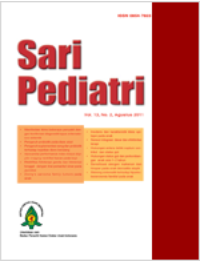Gambaran Cairan Serebrospinal pada Pasien Anak dengan Infeksi Susunan Saraf Pusat di Rumah Sakit Rujukan Jawa Barat
Sari
Latar belakang. Infeksi pada susunan saraf pusat (SSP) dapat memberikan dampak permanen, seperti ganguan fungsi kognitif dan fisik apabila terlambat mendapatkan penanganan. Perubahan komposisi cairan serebrospinalis (LCS) dapat digunakan sebagai indikator pada infeksi SSP. Studi kepustakaan pada karakteristik perubahan komposisi LCS masih sulit ditemukan sehingga diperlukan studi lebih lanjut mengenai hal ini.
Tujuan. Mengetahui gambaran LCS pada pasien anak dengan infeksi susunan saraf pusat.
Metode. Deskriptif potong lintang terhadap rekam medis pasien anak dengan infeksi susunan saraf pusat rawat inap di RSUP Dokter Hasan Sadikin Bandung periode Januari 2015-Agustus 2019.
Hasil. Dari 211 subjek penelitian dengan rentang usia 1 bulan hingga 18 tahun diperoleh rerata usia 7,18, median usia 5, dan standar deviasi usia 6,53. Diperoleh pada kelompok usia 1 bulan-2 tahun 39,8%, 3-6 tahun 14,7%;, 7-12 tahun 12,8%; dan 13-18 tahun 32,7%. Diperoleh 45,5% sampel merupakan infeksi tuberkulosis (TB), 21,3% sampel infeksi virus, 9,5% sampel infeksi bakteri, dan 23,7% sampel infeksi tidak spesifik.
Kesimpulan. Pemeriksaan LCS sangat penting dilakukan untuk menunjang diagnosis infeksi SSP. Sebagian besar LCS menunjukkan gambaran infeksi yang disebabkan oleh TB
Kata Kunci
Teks Lengkap:
PDFReferensi
Khasawneh AH, Garling RJ, Harris CA. Cerebrospinal fluid circulation: What do we know and how do we know it? Brain Circ 2018;4:14–8.
Spector R, Robert Snodgrass S, Johanson CE. A balanced view of the cerebrospinal fluid composition and functions: Focus on adult humans. Exp Neurol 2015;273:57–68.
Brown BL, Fidell A, Ingolia G, Murad E, Beckham JD. Infectious causes and outcomes in patients presenting with cerebral spinal fluid pleocytosis. J Neurovirol 2019:25:448-56.
Roca A, Bassat Q, Morais L, Machevo S, Sigaúque B, O’Callaghan C, dkk. Surveillance of Acute Bacterial Meningitis among Children Admitted to a District Hospital in Rural Mozambique. Clin Infect Dis 2009;48:S172–80.
Kim KS. Acute bacterial meningitis in infants and children. Lancet Infect Dis 2010;10:32–42.
Amini M, Bahador M, Bahador M. Common cause and cerebrospinal fluid changes of acute bacterial meningitis. Iran J Pathol 2009;4:75–9.
Collins D, Hafidz F, Mustikawati D. The economic burden of tuberculosis in Indonesia. Int J Tuberc Lung Dis 2017;21:1041–8.
Bang ND, Caws M, Truc TT, Duong TN, Dung NH, Ha DTM, dkk. Clinical presentations, diagnosis, mortality and prognostic markers of tuberculous meningitis in Vietnamese children: A prospective descriptive study. BMC Infect Dis 2016;16:1–10.
Regeniter A, Kuhle J, Mehling M, Möller H, Wurster U, Freidank H, dkk. A modern approach to CSF analysis: Pathophysiology, clinical application, proof of concept and laboratory reporting. Clin Neurol Neurosurg. 2009;111:313–8.
Baud MO, Vitt JR, Robbins NM, Wabl R, Wilson MR, Chow FC, dkk. Pleocytosis is not fully responsible for low CSF glucose in meningitis. Neurol Neuroimmunol NeuroInflamm 2017;5:e425.
Shenoy A, Desai H, Mandvekar A. Cerebrospinal fluid – A clinicopathologic analysis. J Assoc Physicians India 2017;65:40–3.
Chu KH, Bishop RO, Brown AF. Spectrophotometry, not visual inspection for the detection of xanthochromia in suspected subarachnoid haemorrhage: A debate. EMA - Emerg Med Australas 2015;27:267–72.
Thuong NTT, Vinh DN, Hai HT, Thu DDA, Nhat LTH, Heemskerk D, dkk. Pre-treatment cerebrospinal fluid bacterial load correlates with inflammatory response and predicts neurological events during tuberculous meningitis treatment. J Infect Dis 2019;219:986–95.
Young P, Saxena M, Bellomo R, Freebairn R, Hammond N, Van Haren F, dkk. Acetaminophen for fever in critically III patients with suspected infection. N Engl J Med 2015;373:2215–24.
Marx GE, Chan ED. Tuberculous Meningitis: Diagnosis and Treatment Overview. Tuberc Res Treat 2011;2011:1–9.
Butler P, Shah R, Kas-Osoka O, Galvis AE. Tuberculosis Meningitis in a Immunocompetent Host. Am J Case Rep 2016;17:977-81.
Chin JH. Tuberculous meningitis: Diagnostic and therapeutic challenges. Neurol Clin Pract 2014;4:199–205.
Ai J, Xie Z, Liu G, Chen Z, Yang Y, Li Y, dkk. Etiology and
prognosis of acute viral encephalitis and meningitis in Chinese
children: A multicentre prospective study. BMC Infect Dis 2017;17:1–7.
Storz C, Schutz C, Tluway A, Matuja W, Schmutzhard E, Winkler AS. Clinical findings and management of patients with meningitis with an emphasis on Haemophilus influenzae meningitis in rural Tanzania. J Neurol Sci 2016;366:52–8.
Barichello T, Generoso JS, Simões LR, Goularte JA, Petronilho F, Saigal P, dkk. Role of Microglial Activation in the Pathophysiology of Bacterial Meningitis. Mol Neurobiol 2016;53:1770–81.
Van de Beek D, Cabellos C, Dzupova O, Esposito S, Klein M, Kloek AT, dkk. ESCMID guideline: Diagnosis and treatment of acute bacterial meningitis. Clin Microbiol Infect 2016;22:S37–62.
Khanna A, Sinha A, Periwal P, Talwar D. Hyper somnolence in Kleine-Levin syndrome secondary to tuberculous meningitis. Astrocyte 2015;2:52.
DOI: http://dx.doi.org/10.14238/sp21.6.2020.339-45
Refbacks
- Saat ini tidak ada refbacks.
##submission.copyrightStatement##
##submission.license.cc.by-nc-sa4.footer##
Email: editorial [at] saripediatri.org


Sari Pediatri diterbitkan oleh Badan Penerbit Ikatan Dokter Anak Indonesia
Ciptaan disebarluaskan di bawah Lisensi Creative Commons Atribusi-NonKomersial-BerbagiSerupa 4.0 Internasional.




